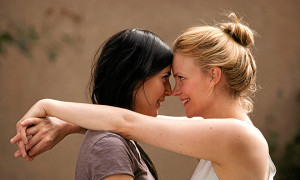Portraying gay love in Film can be very challenging. There is always a risk of propagating stereotypes, especially if they are made by non-queer people. Lesbian relationships have not been depicted very often in mainstream film and those films that do are not always well-received by the community.
Blue is the Warmest Color, Abdellatif Kechiche’s three-hour film about the love between two women for example was widely criticised for not portraying the women and their sex life realistically. Even the author of the graphic novels it is based on, Julie Maroh, has distanced herself from the film. The argument is that a male director and two seemingly straight actresses could never have produced a realistic portrayal of lesbian love. The Kids are All Right is also problematic because of one of the protagonist’s extra-marital affair with a man, giving the impression that a heterosexual relationship is more fulfilling. It is worth having a look at the way other films depict lesbian relationships.
Let’s start with a satirical depiction of life in a camp that tries to turn gay teenagers into ‘normal’, straight people. But I’m a Cheerleader, by Jamie Babbit, is a bright, neon comedy that packs all the stereotypes people have about gay people. There is the butch girl, who acts like a man, the lipstick lesbian who wishes she were straight and the rebellious girl who wants to challenge society. With these stereotypes, the film manages to ridicule the belief of the camp leader that she can change people’s sexuality. Her methods as well are beyond silly, as she believes that if she makes the girls do domestic chores and the boys chop wood, she will succeed in turning them. Thus, not only LGBT stereotypes are used, but also gender stereotype of the woman taking care of the household and the man providing for the family. Even though the film uses all these stereotypes, its message is clearly that they are rubbish. The girls need to overcome them because they ultimately don’t matter.
In Heavenly Creatures, two girls in 1950s New Zealand fall for each other when they notice they share an incredible imagination. They bond over their childhood illnesses, their vivid drawings, and the fantasy kingdom of Borovnia. Pauline is a more butch girl, who thinks all the other girls are silly because they love dolls. Juliet is very lonely, and seeks validation for her ideas, such as the 4th Heaven she will go to when she dies. Their relationship and their love for each other is portrayed very innocently. They don’t seem to realise until very late how far their affection goes. Unfortunately, their endearing imagination is taken a step too far so that they seem hysterical and mad. The fact that they kill Pauline’s mother to be together, adds to them being perceived as mentally impaired. The film is thus another example of prejudice against homosexuality and its being linked to mental illness and lack of morality, which might just be caused by director Peter Jackson’s own imagination.
Kyss Mig is a Swedish film that portrays the relationship between its protagonists Frida and Mia very lovingly. They are two successful women who think they have their life sorted until they meet and fall in love. It is a very honest portrayal of their love, and is delivered very realistically. The acting is understated but great in its simplicity. It is probably due to the producer, openly gay Josefine Tegblad, that the film is this close to real life. She wanted to depict the lesbian relationship as she knows it. 
If These Walls Could Talk 2, a film that portrays three relationships in three different decades, gives the audience a peek into the struggles lesbians face in their respective environments. It is set in the same house, but centres around three different couples. In 1961, Edith suddenly has to deal with the death of her partner, and needs to fight to be recognised by her relatives. In 1972, four lesbian students fight for their right to be a recognised part of their university, and in 2000, two lovers are picking out sperm donors to start a family. While Edith and Abby live a quiet life, trying not to upset people around them, Linda and her friends step up for themselves and cause trouble. Interestingly, they apply lesbian stereotypes themselves, on women they deem to be too manly. Fran and Kal have designated roles in their relationship, Kal being the husband, and Fran the traditional wife who wants to get pregnant.
Lesbian women are presented in many different ways in film, but overall, prejudices prevail. Some films, like But I’m a Cheerleader, may ridicule these stereotypes, but others do nothing to dispel negative ideas about homosexuality. Of these films, Kyss Mig is probably the best portrayal of gay love, perhaps because it is understated but real (and produced by a woman who knows what she puts on the screen).






